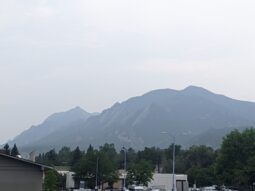Go offline with the Player FM app!
Wildfires & Smokey Skies
Manage episode 431482896 series 49299

Wildfire smoke has marred the Front Range in recent weeks, due to Megafires that are likely to become more frequent. And more smoke is likely.
Fire Weather: A True Story from a Hotter World (Starts 00:00) Beth Bennett speaks with author John Vaillant about the Canadian firestorm that forced 100,000 people to run for their lives . . . and why firestorms like this are becoming more common. (For extended version, go here)
Smokey Skies (Starts 15:00) The Front Range is getting eye-stinging smoke from wildfires over 1,000 miles away . . . last week, from Canada, and this week, likely from California, according to the Colorado Smoke Blog. University of Utah Atmospheric Scientist Dr. Derek Mallia speaks with Rocky Mountain Community Radio Director, Maeve Conran, about why wildfire smoke travels so far, and how people can protect themselves from its toxic effects.
Host/Producer: Shelley Schlender
Additional Contributions: Beth Bennett and Maeve Conran
Executive Producer: Susan Moran
706 episodes
Manage episode 431482896 series 49299

Wildfire smoke has marred the Front Range in recent weeks, due to Megafires that are likely to become more frequent. And more smoke is likely.
Fire Weather: A True Story from a Hotter World (Starts 00:00) Beth Bennett speaks with author John Vaillant about the Canadian firestorm that forced 100,000 people to run for their lives . . . and why firestorms like this are becoming more common. (For extended version, go here)
Smokey Skies (Starts 15:00) The Front Range is getting eye-stinging smoke from wildfires over 1,000 miles away . . . last week, from Canada, and this week, likely from California, according to the Colorado Smoke Blog. University of Utah Atmospheric Scientist Dr. Derek Mallia speaks with Rocky Mountain Community Radio Director, Maeve Conran, about why wildfire smoke travels so far, and how people can protect themselves from its toxic effects.
Host/Producer: Shelley Schlender
Additional Contributions: Beth Bennett and Maeve Conran
Executive Producer: Susan Moran
706 episodes
All episodes
×Welcome to Player FM!
Player FM is scanning the web for high-quality podcasts for you to enjoy right now. It's the best podcast app and works on Android, iPhone, and the web. Signup to sync subscriptions across devices.




